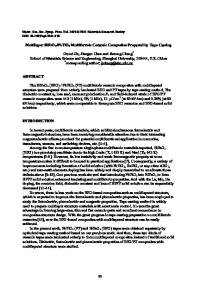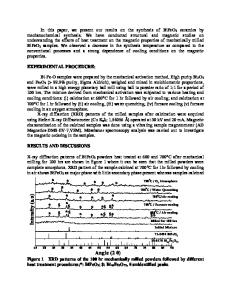Phase Transitions in Multiferroic BiFeO 3
- PDF / 197,966 Bytes
- 6 Pages / 612 x 792 pts (letter) Page_size
- 56 Downloads / 380 Views
0987-PP05-02
Phase Transitions in Multiferroic BiFeO3 Alexander G. Gavriliuk1,2, Viktor Struzhkin1, Igor S. Lyubutin3, Ivan A. Trojan3,4, Michael Y. Hu5, and Paul Chow5 1 Geophysical Laboratory, Carnegie Institution of Washington, 5251 Broad Branch Road NW, Washington, DC, 20015 2 Institute for High Pressure Physics, RAS, Kaluzhskoe sh., Troitsk, Moscow region, 142190, Russian Federation 3 Institute of Crystallography, RAS, Leninskii prospekt 59, Moscow, 119333, Russian Federation 4 Max Planck Institute fur Chemie, Postfach 3060, Mainz, 55020, Germany 5 HPCAT and Carnegie Institution of Washington, Advanced Photon Source, ANL, Argonne, IL, 60439
ABSTRACT The multiferroic BiFeO3 crystals were studied under high pressures up to 70 GPa created in diamond anvil cells. Electronic, magnetic and structural transformations were found in the region 40-55 GPa. Electronic transition with high-spin (HS) to low-spin (LS) crossover at the Fe3+ ion, suppression of magnetism and metallization were carefully investigated and documented. All transitions are completely reversible. The proposed theoretical consideration explains some details of the high-pressure magnetic, optical and electronic properties. INTRODUCTION As expected from theory, the effects of suppression (or breakdown) of strong electron correlations at high pressures will provide the experimental test and model verification tool and provide new data for the development of theory. This field includes materials of great importance for applications such as spintronic systems and multiferroics, substances with colossal magneto-resistance and magneto-electric effect, and high-temperature superconductors. The progress in this field is also closely related to the new fast-growing branch of material science – spintronics. The knowledge of properties and interactions between magnetic and electronic subsystems obtained from high-pressure experiments will provide practical and theoretical basis for the optimization of characteristics and parameters of these new materials having enormous potential for creation of spintronic devices. The bismuth ferrite BiFeO3 belongs to a class of antiferromagnetic ferroelectric materials (multiferroics), which have both a spontaneous electrical polarization and a spontaneous magnetization [1,2]. Due to a record high for multiferroics the antiferromagnetic Neel temperature (TN = 643 K) and ferroelectric Curie temperature (TC = 1083 K) [3,4], the BiFeO3 crystal is most attractive from both fundamental and applied aspects of science. In the present studies we applied the high pressure technique to investigate the structural, electronic, and magnetic properties of BiFeO3 in the region of phase transition. EXPERIMENT The multiferroic BiFeO3 crystals were studied under high pressures up to 70 GPa created in diamond anvil cells. The single crystals enriched with Fe-57 isotopes have been prepared for nuclear resonance measurements. Integrated studies including the Mössbauer transmission and
3
Volume (Å )
Mössbauer synchrotron (Nuclear Forward Scatt
Data Loading...











